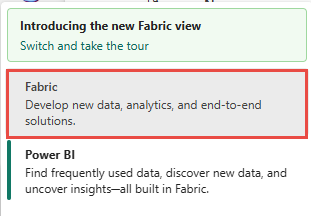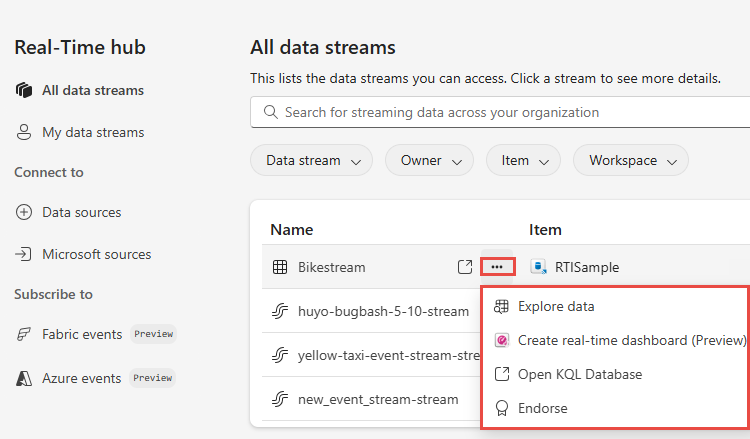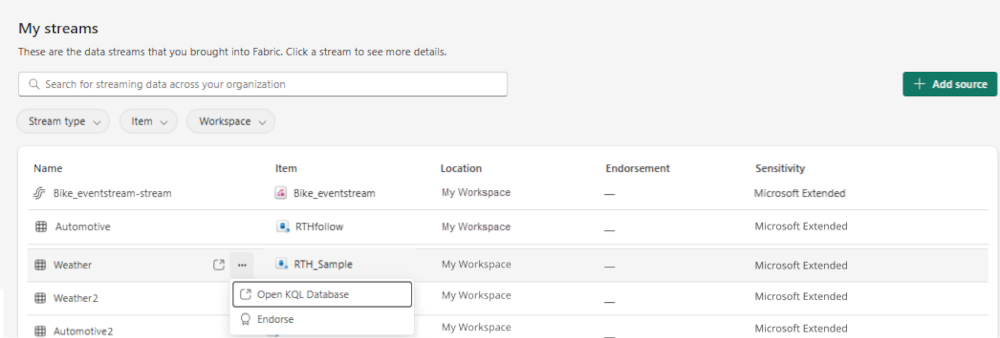Get started with Fabric Real-Time hub
Real-Time hub is the single estate for all data-in-motion across your entire organization. Every Microsoft Fabric tenant is automatically provisioned with Real-Time hub, with no extra steps needed to set up or manages it. For detailed overview, see Real-Time hub overview.
This article provides guidance on getting started with Fabric Real-Time hub.
Navigate to Real-Time hub
Sign in to Microsoft Fabric.
If you see Power BI at the bottom-left of the page, switch to the Fabric workload by selecting Power BI and then by selecting Fabric.

Select Real-Time on the left navigation bar.
All data streams page
On the All data streams page, you see all the streams and tables you can access. Streams are the outputs from Fabric eventstreams and tables are from Kusto Query Language (KQL) databases that you can access.
For a data stream of type stream, there are four actions available: -
Preview data to preview data in the stream.
Open eventstream to open the eventstream that outputs the data stream.
Endorse option to endorse stream for others to use.
For a data stream of type KQL table, there are four actions available:
Explore data option to explore data in the KQL table.
Create real-time dashboard (Preview) option to create a real-time dashboard based on data in the KQL table.
Open KQL Database option to open the KQL database that contains the table.
Endorse option to endorse data in the KQL table.
My data streams page
The My data streams page shows all the streams you brought into Fabric into your workspace. To explore your streams and tables, use instructions from Explore my streams in Fabric Real-Time hub.
The actions available for streams or KQL tables are same as the ones mentioned in the previous All data streams section.
Data sources page
You can connect to data from both inside and outside of Fabric in a mere few steps within Fabric Real-Time hub. Whether data is coming from new or existing sources, streams, or available events, the Connect data source experience allows you to connect to a wide range of event sources directly from Real-Time hub.
It allows for easy connectivity to external data streams including Kafka connectors powered by Kafka Connect and Debezium connectors for fetching the Change Data Capture (CDC) streams. Connectivity to notification sources and discrete events is also included, which enables access to notification events from Azure and other clouds solutions including Amazon Web Services and Google Cloud Platform.
There are two ways you can get to the Data sources page:
By selecting + Connect data source on the All data streams or My data streams pages.
By selecting + Data sources under Connect to category on the left navigation menu.
Then, follow the prompts to complete the flow. Here's a full list of built-in sources.
You can connect to these services and create eventstreams that show up on My data streams and All data streams pages. Select a link for a source in the list to learn how to create an eventstream for that source.
Microsoft sources page
Microsoft sources page in the Connect to section shows you all the Microsoft data sources you can access. They include sources of the following types.
You can connect to these resources and create eventstreams that show up on My data streams and All data streams pages. Select a link for a source in the list to learn how to create an eventstream for that source.
Fabric events page
The Fabric events page shows you the list of system events generated in Fabric that you can access. You can create eventstreams for events from your Fabric workspaces. You can also set up an alert to send notifications via email, Teams etc. when an event occurs. Use links from the list to navigate to articles that show you how to create eventstreams for Fabric workspace item events.
- Fabric Workspace Item
- Explore Fabric events in Real-Time hub.
- Set alerts on Fabric workspace item events
Azure events page
The Azure events page shows you the list of system events generated in Azure that you can access. You can create eventstreams for events from your Azure blob storage. You can also set up an alert to send notifications via email, Teams etc. when an event occurs. Use links from the list to navigate to articles that show you how to create eventstreams for Azure Blob Storage events.
See following articles to learn how to setup alerts on Fabric events:








